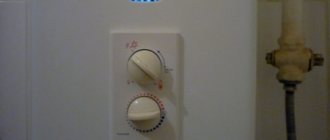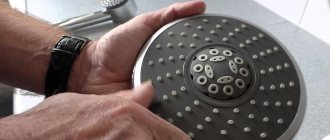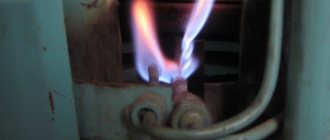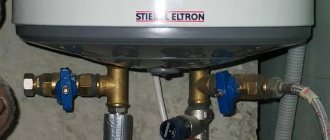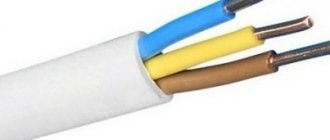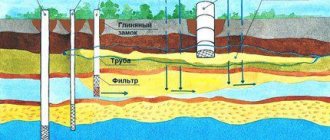The main and main purpose of geysers is to quickly heat cold water in an apartment or private house. But this device, despite its relatively simple design, requires regular maintenance, otherwise it works worse and worse until it completely stops performing its functions. In a situation where the gas water heater does not heat the water, there are two options: the first is to seek advice and help from specialists, the second is to try to diagnose and fix the problem on your own. In the latter case, you need to know the operating principle of a gas water heater and understand the types of breakdowns that could occur with the device.
Operating principle and causes of geyser malfunction
The operating principle of any geyser, be it modern or old Soviet, is very simple. Gas is supplied inside the device, which during the combustion process releases heat, heating the heat exchanger and the coil passing around it along with the flowing water . It turns out that cold water is supplied to the column from the water supply, which heats up as it moves along the coil, and the already hot water moves to the point of intake: the tap or shower. In this case, gas combustion products are discharged into the chimney, and from there to the street.
There can be many reasons why the column does not heat the water. These include:
- prolonged lack of device maintenance;
- membrane that has lost elasticity due to long-term use;
- clogged chimney;
- heat exchanger wear;
- malfunction of the ignition system;
- weak water pressure;
- problem in the water supply system;
- scale formation;
- low-power burner.
In order for the geyser to start heating water again, it is necessary to diagnose the device, identify the malfunction and fix it on your own or with the help of a specialist.
Descaling the system
The water in Russian pipes has never been of good quality, therefore, during the operation of gas equipment, various salts and metals accumulate on the internal sections of the heat exchanger. In this case, the diameter of the outlets gradually narrows, and the scale layer reduces the thermal output of the entire system.
It turns out that with an acceptable water pressure, the pipes do not heat up sufficiently, and we get a significant decrease in efficiency. But this problem can be dealt with on your own. To clean the radiator from scale, simply rinse it. Depending on the degree of contamination, citric acid is used, and in difficult cases, specialized detergents are used.
We recommend reading: What type of paint is recommended to paint heating radiators
Dismantling the geyser heat exchanger
To fully clean the system, it is necessary to remove the radiator from the gas water heater. Washing some individual parts is less effective, but if it is impossible to dismantle the element in principle, then you have to be content with little.
Before dismantling, it is necessary to turn off the column and turn off the gas and water supply taps. You also need to drain all liquid from the system. We release the panel behind which the radiator is located by unscrewing the fasteners and remove it. Carefully remove the heat exchanger, trying not to tilt it, because there is probably water left there.
Cleaning the heat exchanger from scale
The cleaning procedure itself is extremely simple: pour citric acid or a specialized product into the radiator and leave it for a couple of hours in some warm place. During this time, the composition will react with the scale and discharge it. Next, we rinse the heat exchanger with running water and install it in place in the reverse order of disassembly. If necessary, repeat the cleaning procedure.
Diagnostics and troubleshooting
Diagnostics of a gas heater includes its thorough examination to identify possible causes that led to a decrease in the efficiency of the device, and their subsequent elimination.
Clogged chimney
The first reason why the water is barely warm or does not heat up at all is a blockage in the ventilation of the gas water heater.
Important! A chimney clogged with smoke, soot or other debris cannot provide the draft necessary for operation, so the water heater's protective systems stop the gas supply.
You can determine such a malfunction by placing a lit match near the ventilation hole. If the flame burns evenly, without hesitation, this means there is no draft. This version is also supported by falling flakes of black soot. Another sign is that the fire burns with a yellow flame. This situation arises in the absence of regular cleaning of the column.
You can fix this problem yourself; to do this, you need to clean the ventilation shaft from soot, debris and other foreign objects. To check the chimney for draft after work, you can take a burning candle or lighter and bring it to the ventilation. If the flame deviates significantly, it means there is draft.
Heat exchanger wear
With prolonged operation, the heat exchanger wears out and a leak may occur. This is typical for parts of poor quality, in which the element is not made of pure copper, but with impurities. At the sites of impurities, the surface oxidizes and fistulas appear.
Advice! If the cracks or holes are small, you can try to solder them, but the best solution would be to completely replace the heat exchanger.
Problem with the ignition system
If the flame does not light in a Bosch or Neva dispenser with automatic ignition and the water does not heat up, you need to check the condition of the batteries. They tend to regularly discharge and fail, and sometimes oxidize. In some cases, defective batteries may be found. To check the ignition system, you need to change the batteries and, if the problem persists, diagnose the button that supplies the spark to ignite the gas .
Insufficient pressure
Sometimes a geyser may not perform its functions due to the fact that the protection system against turning on without water is triggered. This can happen if there is poor pressure in centralized water supply pipes. To verify this reason, you need to open the cold water tap valve and look at the stream. If it really flows weakly, then there are problems in the water supply.
To correct the situation, you must first call the utility company and find out if they are carrying out maintenance or repair work. If the answer is negative, you should clean the filters at the entrance to the gas water heater and/or the water supply system in the house from dirt and debris.
Advice! To clear clogged pipes in an apartment building, you must submit a request to the utility service.
In addition to these actions, you need to clean the gas water heater from soot and dust, and also check the integrity and proper functioning of the membrane, and if necessary, install a new part.
Irregularities in water supply
Such a breakdown occurs rarely and indicates incorrect settings of the water heater. If the flame lights up but goes out immediately or after a short time, this indicates an imbalance in the hot and cold water supply system.
Advice! On many forums you can read the opinion of experts that it is not recommended to mix cold water with hot water while the water heater is operating, since this does not comply with the rules for operating the device and also leads to extinction of the flame.
To eliminate this problem, you need to reduce the flow of cold water.
Malfunction in the separating membrane
If the membrane installed in the check valve has worked for a long time, it may cause a malfunction of the gas water heater. Due to regular loads and constant work, the unit tends to deform. As a result, the burner ignition sensor becomes less sensitive, gas does not flow to the burner, and the flame goes out. It is impossible to prevent such damage; even the highest quality membranes gradually lose their elasticity during operation . Speaker manufacturers, as well as service specialists, advise replacing this part every five to seven years of continuous operation.
You can make sure that the cause of the breakdown is the membrane by turning on the water flow to maximum. If the gas burner goes out, the diagnosis can be considered confirmed. To fix the problem, you will need to replace the part.
The flame goes out
If the gas water heater ignites properly, but goes out during operation, this may indicate a breakdown of the bimetallic sensor. It is designed to measure temperature to protect the water heater from overheating. Such a malfunction can manifest itself in different ways.
- In some cases, the device turns on, heats the water, but soon goes out, and it is impossible to restart it. After about ten minutes, the column turns on again, works and goes out again after a short time. This is due to the increased sensitivity of the bimetallic sensor.
- In other cases, the column lights up and goes out after an arbitrary time without any visible dependence. It is impossible to guess how long it will work properly. This type of failure is usually caused by damaged wiring. Due to broken insulation, short circuits to the housing occur, and the fuse also trips.
Important! Malfunctions of the bimetallic sensor cannot be eliminated independently. In this situation, you need to seek help from professionals.
In some cases, the device overheats in the summer due to extreme heat and stuffiness in the bathroom (or other room). This is not a defect, but to prevent blackouts, you can move the column to another room or seek advice from professionals.
Scale
Another reason why a Beretta, Junkers, Vektor or other manufacturer’s water heater does not heat water or heats it very poorly is scale on the heat exchanger. In this case, the gas enters the device in the required volume, the pressure is good, and water moves in the system in the required quantity, but it will not be able to warm up above 34 degrees.
The appearance of scale is explained by the contact of metal elements of equipment with hard water or the igniter running idle . After the central system is turned off, but the pilot light is on, the heat exchanger evaporates the remaining moisture, thereby increasing the amount of scale. Since running water does not wash away such plaque, it accumulates and becomes tightly attached to the walls. When there is a lot of scale, the heat exchanger stops heating, which means the column stops heating the water. To fix the breakdown, you need to wash the heating element in a special solution. To do this, you can contact specialists or try to do it yourself.
Advice! To clean the heat exchanger from scale, you will need a special product. You can use household chemicals that eliminate limescale, or you can use table vinegar or citric acid.
To disassemble the column, you need screwdrivers, a set of keys, silicone gaskets corresponding to the diameter of the pipe, as well as a tube and funnel for pouring the solution into the heat exchanger. So, to disassemble the water heater, you need to remove the regulators and other fittings, unscrew the fasteners and remove the housing, then turn off the tap at the entrance to the device and open the hot water valve located near the column. Next, you should unscrew the nut, remove the incoming water tube from the heat exchanger and drain the remaining water, the amount of which can be from a liter to one and a half.
After this, you need to connect a rubber tube with a funnel to the coil, place it above the device and gradually pour in up to two liters of descaling solution. The amount depends on the power of the water heater. Then you need to keep the liquid inside for at least two and a half hours, preferably longer. After the designated time has expired, you need to connect the coil to the water supply, open the hot water tap and drain the waste liquid. Next, you need to flush the system and, if desired, repeat the cleaning procedure.
Advice! To prevent scale formation, it is recommended to install a protective filter at the inlet of the column.
How to clean the heat exchanger?
Sometimes it happens that the geyser does not heat well and generally stops glowing brightly. The reason often lies in the accumulation of excess dirt and soot on the internal walls of the burner.
To clean the column from excess dirt inside on your own, it is recommended to use lemon acid or household chemicals purchased at a hardware store. You can also attach a pump to the gas water heater to circulate water so that it actively moves through the heat exchanger manifolds. If a pump is not used to circulate water in everyday life, then you can simply pour citric acid or descaling agent into the pipes, wait a while and see the “bubbly” cleaning process. The mixture of water and scale in the form of bubbles should be carefully drained after the bubble reaction has formed. As soon as the heat exchanger is installed back, open the tap so that the water pressure washes away any remaining soot contamination.
Breakage Prevention
To avoid problems with the operation of the geyser, it is necessary to carry out its maintenance at least once a year . It is recommended to call professionals for these procedures, but if you want to save money and perform these steps yourself, you need to disassemble the device, first turning off the gas supply, and thoroughly clean the inside with a brush or rag. To improve the effect, you can use a vacuum cleaner.
Advice! In addition to the water heater, you need to inspect and clean the chimney, since if it is clogged, even a clean water heater will not work. In addition to removing soot and soot, you need to periodically clean the heat exchanger from scale, especially if the pilot light is regularly lit during the day.
So, if a geyser does not heat water well or does not heat it at all, it is necessary to diagnose the device to identify the cause of the malfunction. This problem can cause many breakdowns of this type of water heater, many of which occur due to the lack of regular preventive maintenance of the device. Once a malfunction is detected, you can try to fix it yourself or seek help from specialists if you are not confident in your own abilities.
Weak water heating
If, after eliminating the leak and cleaning the radiator, the water in the column still does not heat up to the proper level, then you should pay attention to other indirect reasons:
- insufficient gas pressure;
- faulty mixer;
- filter elements.
If gas arrives at the inlet from a pipeline or cylinder with insufficient pressure, the water simply does not physically have time to heat up. The solution to this problem is best left to the shoulders of gas service specialists.
It is easy to determine whether a mixer is faulty. All you have to do is put your hand on the hot water hose that runs under the sink. If it is cold, then the problem is with the gas boiler, and if not, then we adjust the mixer or change it.
One of the most common reasons for warm water instead of hot water is clogged filters. It is worth checking everything that has a grate or any independent cleaning modules along the way from the gas boiler to the mixer, and, if necessary, remove obstacles by thoroughly washing the elements.
Here is a short list of reasons why a regular gas water heater does not heat water. Some of them are easy to fix on your own, while others require professional intervention. Remember to take precautions when working with gas equipment and follow all instructions from professional mechanics. Among other things, timely replacement of wear parts will help avoid most breakdowns.
The role of a gas burner in the process of heating water
A gas burner provides the process of heating water through the reaction of mixing gas and air, which during the combustion process work on the heat exchanger, heating it. Homogeneous and correct mixing of gas with air depends primarily on the well-designed design of the gas burner itself.
By the way, gas burners are rarely subject to breakdowns, but they often become unusable due to contamination of the internal walls with soot and scale. Some models of geysers have special holes that allow you to control the operation of the burners and the combustion process. If there are no such windows, you can simply remove the front panel of the burner and clean it yourself. The holes that allow gas to pass through should be carefully cleaned using a special descaling agent or using citric acid.
Reasons why the water assembly rod may jam
If the rod on the water unit is in a state of malfunction, then there is no need to panic in such cases - make sure that when using a hot water tap, the flame will not increase with renewed vigor. If fuel combustion occurs intermittently, inconsistently, then try to change the water temperature in case of poor heating.
The malfunction of the unit rod can be eliminated independently and without calling a team of workers. You will need basic tools before repairing: a wrench, screwdrivers with different bits and a Phillips slot.
Cleaning the filter
If the water filter turns out to be contaminated with dust and other waste, accumulations of soot, then the flow of liquid in the column will be too weak for domestic use, the burner will not be able to cope with the gas valve and the gas column will heat poorly. The dirt filter is usually located at the inlet of the gas water heater or on the water hose itself leading into the room. To clean, carefully unscrew the filter and clean it from any dirt that has accumulated there.
A coarse filter that is installed on the cold water supply. Quite often this is the cause of a geyser that does not heat.
